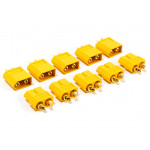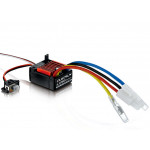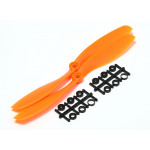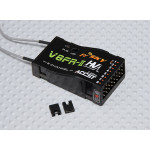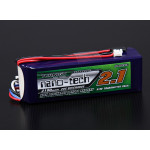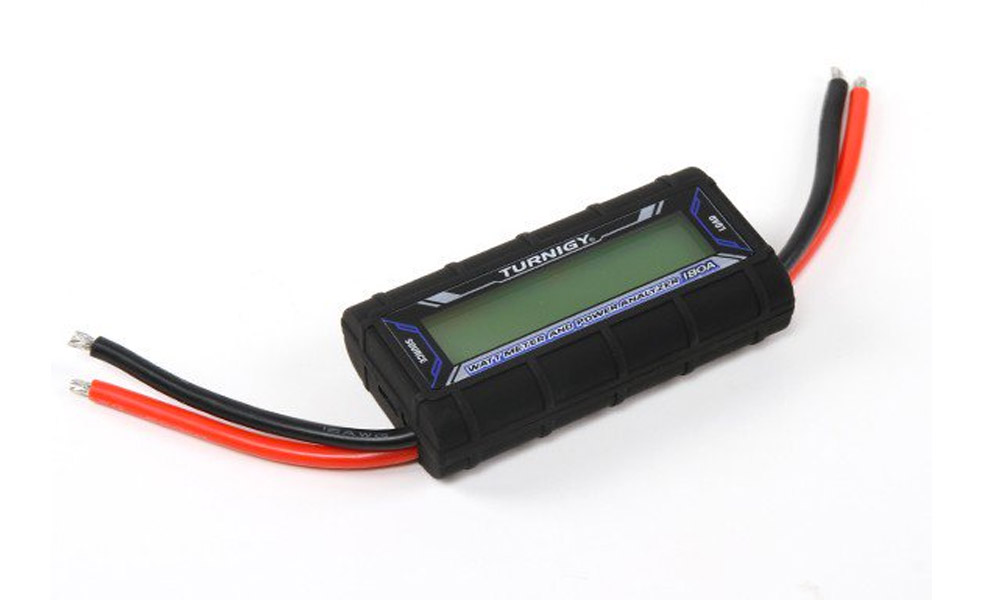
What does a watt meter do and why should I buy do I need one?
Simply put, a wattmeter measures the current draw on your electrical system and displays the results live (watts, amps, and volts). The wattmeter is placed in series, between your battery and ESC, and takes only seconds to use.
Think of a wattmeter as an insurance policy that pays off very quickly. At less than $20 if a watt meter only saves you one ESC, Battery, or motor you’ll be very thankful. If it happens to save you an entire aircraft and a bag full of regret then it should be looked upon as more of an investment.
What is a Watt
Watt is the unit of power (symbol: W). The watt unit is named after James Watt, the inventor of the steam engine. One watt is defined as the energy consumption rate of one joule per second. 1W = 1J / 1s. One watt is also defined as the current flow of one ampere with a voltage of one volt.
How do you calculate watts?
 To determine the wattage, use a simple multiplication formula. The ampere (or amps) is the amount of electricity used. Voltage measures the force or pressure of the electricity. The number of watts is equal to amps multiplied by volts.
To determine the wattage, use a simple multiplication formula. The ampere (or amps) is the amount of electricity used. Voltage measures the force or pressure of the electricity. The number of watts is equal to amps multiplied by volts.
e.g. (V) x (A) = W or (voltage) x (amp draw) = (watts) or (11.1) x (30) = 333watts
How to do you calculate Amperes (amps)
The formula for Watts is Volts times Amps. To calculate amps divide volts by watts.
e.g. (W) / (V) = A or (Watts) / (Voltage) = (Amps) or (333) / (11.1) = 30Amnps
Why is it important to know how many watts or amps my system is drawing?
Your electrical system has a limit that should not be exceeded. As you exceed the limit of your electrical system, heat is generated and resistance increases. As resistance increases so do heat, until you let all the magic smoke out. At this point, you regret not using a wattmeter and you fork out for a new motor or ESC.
Different loads, for example, a new prop, can have a massive impact on the current draw. Going from a 3s battery to a 4s is a good example where a wattmeter is critically important. Get into a habit of using it.
I only have a 30amps ESC, so the ESC cannot exceed 30amps, right?
 Wrong. Your ESC is rated to 30 amps draw but not limited to 30 amps. You must ensure that your load does not exceed 30 amps. Remember: As you exceed the limit of your electrical system heat is generated and resistance increases, as resistance increases so does heat, until you let all the magic smoke out.
Wrong. Your ESC is rated to 30 amps draw but not limited to 30 amps. You must ensure that your load does not exceed 30 amps. Remember: As you exceed the limit of your electrical system heat is generated and resistance increases, as resistance increases so does heat, until you let all the magic smoke out.
What do I do if the Watts indicates that I’m exceeding the limits?
We need to remember that amps are pulled not pushed. If you want to reduce Watts reduce your load. This may mean smaller tires, smaller props, different gearing, etc. If the motor is rated for a much higher current draw you could use a higher rated ESC.
How to use a watt meter to test a power system
A wattmeter is simply plugged into the electrical system between the battery and ESC. I use the Turnigy wattmeter, as it's well-known and very reliable. The moment the wattmeter is plugged into the battery the unit will light up and tell you the battery voltage. For the purposes of testing, always use a fully charged battery and one that is in good condition. In the future, if you change to new batteries be sure to run the wattmeter again and remember that the condition of the battery will affect the power output immensely. This is why people pay more for higher C-Rated packs.
To get a reading you need to power up the system at full throttle but before you do that you need to ensure your plane is restrained and that no loose objects could be drawn into the prop or fan. Slowly move the throttle and watch the readings. Be sure not to exceed the power rating of your ESC, motor, or battery as damage will occur. As you are reading the wattmeter during your full-throttle test, you may wonder why the voltage is dropping? There are two reasons. As the battery works, it loses some of its ability to push out the volts. Remember volts are pressure.
When a high current load is placed on the battery the voltage will immediately drop and the second reason is due to a state of charge. As the battery is drained the voltage drops and in fact, we can measure the state of charge fairly accurately by measuring the state of charge.
When you get to full throttle write down the three key numbers, Volts, Amps, and Watts. Now compare them to the ratings on our battery, ESC, and motor. Is everything within the components specifications? If it is, then we’re good to go! If not, then fix the issue. This may be as simple as choosing a smaller prop or reducing the pitch. If you don’t fix it you’re going to have a bad day.
Written by Gozarian
Hear it First: Join our Mailing List
Sign up to receive new product updates, exclusive discounts, news, and more!

